 |
|||||||||||||||||||
 |
|||||||||||||||||||
| How big is the HighEnd audio community? That's hard to say though the independent web-traffic analysis site Alexa can add at least a bit of context. One needs to remember that Alexa's traffic ratings aren't based on unique users (i.e. how many magazines would one have sold had one been a print publication). Alexa is solely interested in volume traffic tabulated from hits and considered spy ware in how it gathers information. Its accuracy might thus be rightfully up for heated debate. Still, certain comparisons among audio-related websites might give us some idea as to the overall size of audio readership activities versus, say Playboy and thereby suggest that we're all in the wrong business after all. |
|||||||||||||||||||
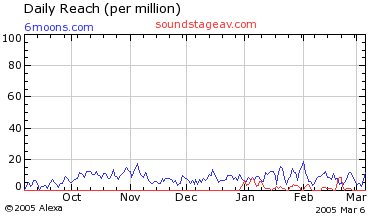 |
|||||||||||||||||||
| The new SoundStage! portal just launched so relevant figures aren't available yet. | |||||||||||||||||||
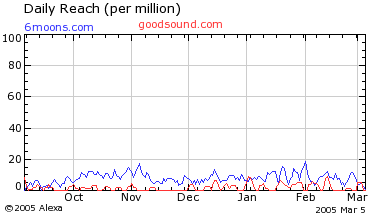 |
|||||||||||||||||||
|
Some of the more specialized audio websites with more limited content expectedly have less traffic than less specialized ones with more content.
|
|||||||||||||||||||
 |
|||||||||||||||||||
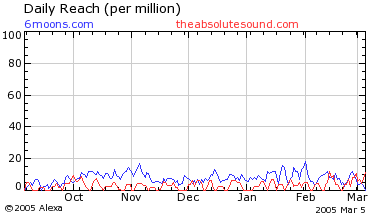 |
|||||||||||||||||||
|
Unlike Stereophile below, The Absolute Sound seems to not yet have maximized their web traffic.
|
|||||||||||||||||||
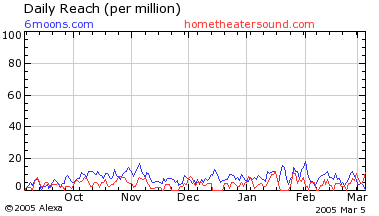 |
|||||||||||||||||||
| Home theater, despite its sales figures, doesn't seem as popular as 2-channel audio, something the SoundStage! graph below suggests by comparison and Ultimate AV's recent move away from print underscores as well. | |||||||||||||||||||
 |
|||||||||||||||||||
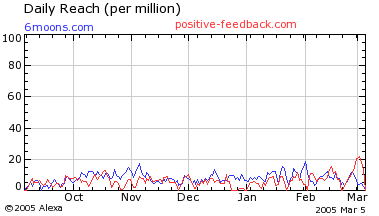 |
|||||||||||||||||||
|
Our friends at PFO hit the web about the same time we launched and our traffic is comparable.
|
|||||||||||||||||||
 |
|||||||||||||||||||
 |
|||||||||||||||||||
| TNT's popularity surely has to with their being a completely advertising-free enterprise. | |||||||||||||||||||
 |
|||||||||||||||||||
|
Something at ETM recently caused their traffic to go though the roof while ours declined due to the subscriber base linking directly to articles which reduced our overall hit rate.
|
|||||||||||||||||||
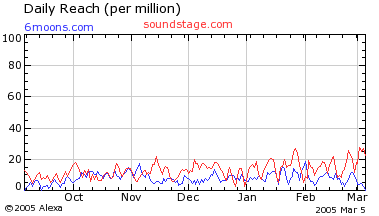 |
|||||||||||||||||||
| As expected, a well-established on-line presence like old timer SoundStage! eclipses our own log-on stats. For a true size of Doug Schneider's emporium, one would have to tabulate the total traffic of all sites organized under his umbrella. | |||||||||||||||||||
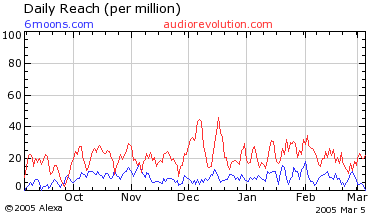 |
|||||||||||||||||||
|
Audio Revolution taps into figures otherwise only achieved by Audio Asylum, Stereophile and Audioholics.
|
|||||||||||||||||||
 |
|||||||||||||||||||
|
Surprisingly perhaps, Stereophile's volume traffic eclipses all of the web-only 'zines and demonstrates how a print magazine can simultaneously enjoy an extremely healthy web portal by tapping into classified ads and e-commerce.
|
|||||||||||||||||||
 |
|||||||||||||||||||
|
As an interactive forum, Audio Asylum likewise dwarfs the content-only sites but isn't much more active than Stereophile.
|
|||||||||||||||||||
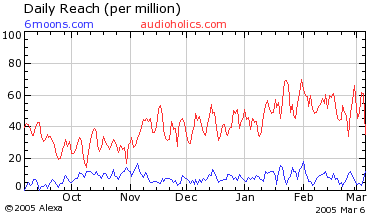 |
|||||||||||||||||||
| Audioholics eclipses all the sites mentioned before... | |||||||||||||||||||
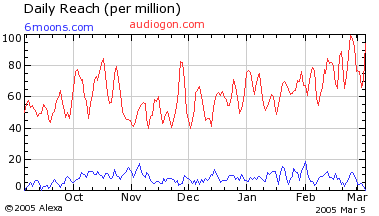 |
|||||||||||||||||||
| ... while AudiogoN's classified wanted/sales format guarantees traffic that towers over everyone else's. | |||||||||||||||||||
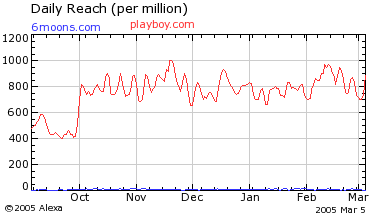 |
|||||||||||||||||||
|
For context, however, Playboy operates in a completely different league altogether. Note how the vertical axis has increased its steps by a factor of 10. This completely flatlines audio's playing field by comparison. If you thought "sex sells" was an outmoded concept, think again.
|
|||||||||||||||||||
The bigger audio e-zines like Enjoy The Music, SoundStage and TNT Audio have been around long enough to suggest that their traffic figures might represent an approximate ceiling of what this type of enterprise can generate without interactive features (though SoundStage! does benefit to a certain extent from the latter). Once you tie into classifieds with the daily action they stimulate, Stereophile and AudiogoN demonstrate what can be achieved if sheer volume were king. Arguably, it is king if you're an advertiser interested in the most visibility even if many of those eyes seeing your ad will belong to the same individuals who log on daily or even hourly. Readers interested in content probably prefer less rather than more ads to be waded through or tolerated on the blinking sidelines just to get to the articles and reviews. If the above graphs are any indication (some might argue they're not) and web-based advertisers begin to demand higher traffic ratings than content alone can generate, the future might hold more rather than less commercialism attached to content. Ad budgeteers often combine Alexa-type ratings with software-generated click-thru ratings on their own servers to assess what each log-on referral from their various ads ends up costing them. Unlike with print where there is no mechanism to quantify ad exposure/viewing with action taken (unless someone were to call up the manufacturer and mention he or she just saw their ad), web-based ad-sponsored publishing can easily be made accountable. While the web has specific advantages over print, this isn't one of them if you're a publisher. But it certainly is a very real advantage to the manufacturers and retailers who want to track their ad campaigns. As far as readers are concerned? One would hope that quality content remains king though certain of the above graphs could suggest something else. In the end, invoking Alexa for this type of comparison could be a fool's errand so take the whole thing with a large grain of salt. For an explanation on website hijacking, traffic rerouting and a major bug in Google's algorithm, go here. |
|||||||||||||||||||
 |
|||||||||||||||||||
 |
|||||||||||||||||||